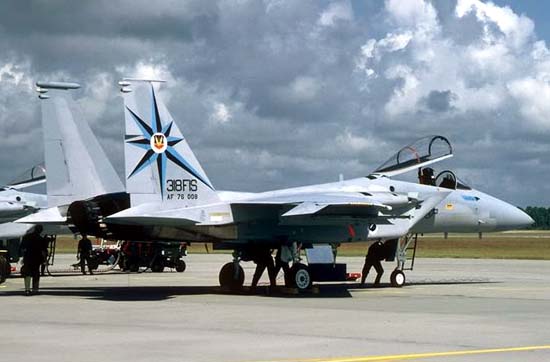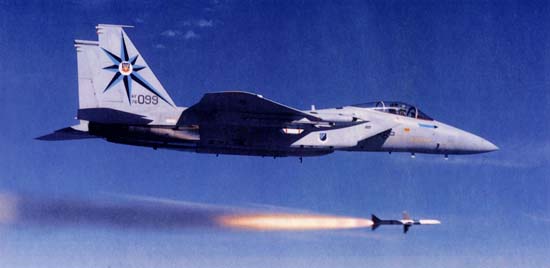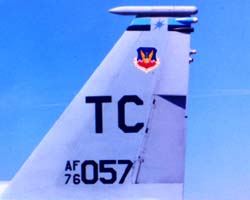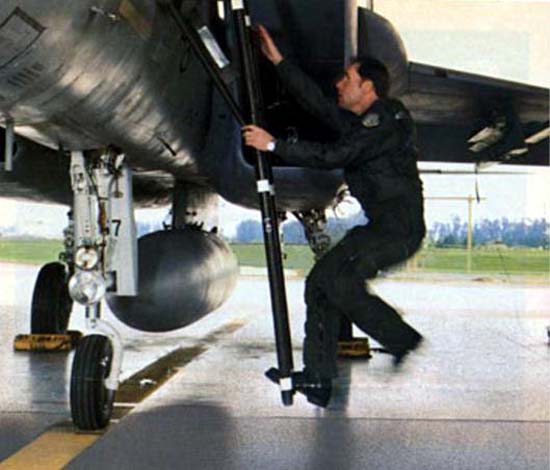_
|
HISTORY |
|
|
|
THE F-15 ERA (1983 - 1989) |
|
|
 |
|
PHOTO FROM
sharpshooter-military aviation journal |
|
The 318th flagship (76-0008)
leads the line of squadron aircraft at William Tell '84.
|
|
|
|
Fully equipped with
F-15s, the 318th resumed the unit's alert commitments at McChord and
Castle
AFB on 30 December 1983.
F-106's assigned from Montana's 120th FIG / 186th FIS 186th FIS and
California's 144th FIW / I94th FIS stood alert at the McChord and Castle
alert sites respectively during the Green Dragons conversion into the
F-15.
|
|
|
|
In May of 1984,
seventeen ADTAC associated squadrons competed in a "Shootout" for six
spots in the 1984 William Tell Weapons Meet. The 318th captured their
invitation to William Tell by beating ADTAC's other fully equipped F-15
unit, the 48th FIS, in competitions carried out in each units home
stations. In their first William Tell, in the F-15 Eagle the Green
Dragons began the Meet on a good note, winning the arrival competition
by passing the Tyndall AFB, FL tower .76 seconds off their predetermined
time. During the competition two 318th FIS Pilots, Team Leader Capt Rich
Hill & future Thunderbird Commander Capt Dan Darnell) scored direct hits
on 2 QF-100D full scaled target drone aircraft, while Green Dragon
Maintenance and Weapons load personnel set high marks during the
competition. An unfortunate string of bad luck doomed the squadron
through the latter parts of the meet, seeing the Green Dragons ending up
in seventh out of the 12-team field.
|
|
|
|
In 1984, the Green
Dragons were once again honored as best Fighter-Interceptor Squadron in
the USAF with award of their second Hughes Trophy. The squadrons
exceptional performance in its air defense mission, accomplishing their
conversion into the F-15 and reestablishing their Air Defense alert
mission more than a month ahead of schedule were some of the many
highlights of a great year. Over the next two consecutive years, the Air
Defense, Tactical Air Command selected the 318th as the organizations
representative quest for the Hughes Trophy.
|
|
|
|
In the year following
the Green Dragons Hughes Trophy win, 23 pilots and 80 maintenance
personnel deployed to Tyndall AFB in March of 1985 to their annual
Combat Archer
air-to-air Weapons System Evaluation Program.
During Combat
Archer, pilots are given the chance to shoot live-fire missiles at
sub-scale and full-scale drones and use their guns on low cost towed
targets. Combat Archer also gives weapons assembler's loaders and
maintainers opportunities to evaluate their procedures, and aircraft
systems. During their two-week Combat Archer deployment, 16 missiles
(AIM-7 radar & AIM-9 heat seeking) were fired by 16 different pilots 12
of whom never fired a missile from an F-15. Green Dragon pilots hit all
nine towed targets during the gun profile, destroying four. A Combat
Archer first was achieved, no missiles were lost to fire control
malfunctions, misfires, or pilot errors the Archer F-15 Program Manager
was quoted "The Green Dragon deployment was the best WSEP (Weapon
System Evaluation Program) I have ever seen!"
|
|
|
|
The second
leg of the deployment involved dissimilar air combat verses F-4's and
F-16's on the Tyndall Air Combat Maneuvering Range.
On the range, all aircraft carrying Air Combat Maneuvering
Instrumentation (ACMI) systems are recorded in a three dimensions where,
each mission is reviewed and securitized by the pilots and trainers.
At the conclusion of the training, the 318th received their share of
complements from the F-16 pilots, with the Green Dragons being called
"the best F-15's they had ever faced".
|
|
|
 |
|
u.s. air Force |
|
After the primary aircraft
experienced a hydraulic leak causing a "ground abort", spare pilot Capt
Tom Watson completed the mission with a successful AIM-7 launch during
William Tell 1984.
|
|
|
|
On 2 June,
five F-15s flew a 5-hour non-stop flight from McChord to
Goose Bay, Labrador to
participate in a weeklong NORAD exercise titled Amalgam Brave 84. In
this exercise, the 318th would get the opportunity to practice low-level
intercepts & tactics against simulated enemy fighters composed of A-10s,
A-7s, RF-4s, German F-4s, T-33s, and CF-101s & Canadian EC-117.
|
|
|
|
In Amalgam
Brave 85, the 318th was assigned to “fight” with the “Blue Team” flying
with Active Air Force, Air National Guard, and Navy squadrons flying
F-106s, F-4s, and F-14. Using an aptly named tactic called "Eaglewacks"
where 318th F-15s would guide fighters to targets using their powerful
radars, Green Dragon pilots missed only one of the 50 shots attempted.
Commenting on the units success, one 318th pilot commented "That gave us
quite a bit of confidence in our ability to counter any threat” “Nobody
else could come close to us”. Maintainers were hampered by the bases
limited amount of support equipment or facilities. To help in the
situation, three C-141s from the 62d MAW loaded with all the equipment &
supplies necessary for the deployment accompanied the squadron. Even
with this challenge, 318th Maintenance turned in an excellent
performance, loosing no sorties to a “broken jet”.
|
|
|
|
On 6 December
1985, the Tactical Air Command reactivated the First Air Force replacing
the Air Defense, Tactical Air Command. One of the four
original air forces, the 1st AF has been associated with air defense
since its activation in 1940.
|
|
|
|
In
November of 1986, the 318th was under the scrutiny of their first
Operational Readiness Inspection in the F-15. In a scenario the
ORI, called an "employment phase", all squadron aircraft are
continuously launched under wartime conditions.
At 11am on 15 November of 1986, as one F-15 returning from
such a mission, suffered a catastrophic landing gear collapse sending
the plane down the McChord runway in a blaze of sparks and smoke
emitting from the crumbling gear and the left external tank (which still
attached to the wing). With McChord Crash Rescue personnel racing to the
scene, the pilot climbed out of and removed himself from the scene
uninjured. After being doused with foam, the fighter was jacked off the
runway and removed. The F-15 was repaired and rejoined to the 318th
flying the squadrons final sortie in 1989. The cause was traced back to
a defect in the gear and process and materials used to maintain the
gear.
|
|
|
|
 |
 |
|
PHOTOS BY ERNEST WHITE - McCHORD AIR MUSEUM |
|
With an order from
TAC HQ, the 318ths trademark "starburst" tailflash was replaced by the
tactical tailcode "TC" (derived from McChord's airport code KTCM/TCM) -
the famed starburst would be moved to the top of the tail in-between a
light blue/dark blue tailstripe.
|
|
|
|
|
In 1987, complying with
orders from Tactical Air Command Headquarters to align all of the
commands aircraft to a uniform standard, the 318th FIS began to repaint
the tails of their F-15's with the tail code "TC", (derived from
McChord's International Air Transport Association airport code of "TCM")
which stood for Tacoma, the major city near the base. The trademark
"Starburst" remained in a much smaller form, contained in the center of
a dark & light blue tail band on the top of the F-15's vertical
stabilizers.
|
|
|
|
When compared the east
coast, pulling alert duty on the west coast can be tedious at times for
interceptor crews, that all changed on one day in the summer of 1987.
Controllers from the Southwest Air Defense Sector scrambled F-15's from
Det. 1, 5th FIS standing alert at Davis-Monthan to identify an unknown
aircraft flying across the US southern border. A positive ID
was made on the aircraft as the fighters approached, the plane, a
Douglas DC-4, was flying low with its navigational lights turned off.
The intercepting pilots were given instructions to shadow the aircraft
and stay out of aircrafts view as it traveled up the California Coast.
|
|
|
|
Responsibility to
follow the aircraft was given to succeeding fighter interceptor located
on the path of the unknown aircraft, as the klaxon sounded at McChord,
two F-15's raced to meet the aircraft just before the Washington Oregon
Border. Not long after the 318th pilots located the DC-4, the mission
took a very strange turn, as the un-identified aircraft approached Long
Beach, WA, it began a slow decent towards land falling below radar
coverage, and with a very low cloud cover, out of visual range.
|
|
|
|
Controllers at the
Northwest Air Defense Sector (NWADS) gave instructions to the F-15's to
perform a "CAP" (or combat air patrol) over the site and report on any
changes in the situation, moments later the DC-4 was in the air. With
suspicions aroused, NWADS alerted the Washington State
Patrol and the US
Drug Enforcement Agency (DEA) of this potential drug trafficking
situation. The plane was followed along the
Washington
Coast where it landed at a local
airport in Arlington WA. Shortly after the DC-4 rolled to a stop,
two men were seen leaving the aircraft and entering a car never to be
seen again.
|
|
|
 |
|
PHOTO FROM THE RON DUFRESNE COLLECTION |
|
Detachment Commander Capt
Ron Dufresne races to his F-15 during a scramble at the
318ths detachment location at Castle AFB, CA.
|
|
|
|
In April of 1987, the
squadron began a series of deployments at Kingsley Field, OR flying
against the students assigned to the 114th
Tactical Fighter Training Squadron, ANG's Air Defense F-4 schoolhouse.
In May, the squadron sent six F-15’s and 3 T-33’s to one of the
most important Air Defense exercises, Copper Flag at Tyndall AFB, FL. In
the exercise, the squadron led all participants in kill rates in a
night / Electronic Countermeasures (ECM) / communication - jamming
environment. The 318th flew with F-4Cs of Oregon's 123d FIS, who both
were considered as leaders in this arena.
|
|
|
|
The Green
Dragons deployed to Alaska in June in a major NORAD/SAC exercise named
Copper Flag, followed by the squadron’s first visit in Red Flag in the
F-15. Green Dragon maintenance was stellar in the 130-degree heat on the
ramps of Nellis, and their efforts paid off in making every sortie, plus
a few extra. The Squadron was busy in September with
deployments to Luke AFB AZ, fighting F-16s, an Air Defense serge at Castle
AFB
with five F-15s fighting F-4s & F/A-18s and deploying two T-33's to a
Copper Flag exercise at Tyndall. October continued with another
deployment to Tyndall for a live fire exercise launching 16 air-to-air
missiles. In December, the Squadron deployed to Nellis to provide
adversary support.
|
|
|
|
In the beginning of
1988, the U.S. Air Force officials announced that the 318th would leave
the F-15 community and transition into the General Dynamics F-16 Air
Defense Fighter (an upgraded version of early model Fighting Falcon) by
mid 1989. With this conversion, the squadrons F-15’s would move south to
re-equip the Oregon Air National Guard's 123rd FIS / 142d FIG "Redhawks"
replacing the units McDonnell Douglas F-4C Phantoms.
|
|
|
|
After 40 years of
dedicated service to the Air Force, a decision was made to retire all
T-33s during 1988. On February 3, 1988 a five-ship formation of 318th
FIS T-33A's saluted the people of McChord flying into history and
retirement to the Arizona
Boneyard. The T-33 was assigned longer than any aircraft at McChord,
flying in the skies of
Washington
for over 37 years. The 318th would donate one of their T-33's s/n
58-2106 (last T-33 built for the Air Force) to the
McChord
Air Museum.
|
|
|
 |
|
u.s. air Force |
|
With 25th Air Division
Commander Brig Gen John M. Davey in the lead, five
of the last T-33's assigned to the 318th FIS fly over Washington State
on their way to retirement in the "Boneyard".
|
|
|
|
After flying more than
60,000 hours in three types of aircraft, the maintainers of the 318th
FIS continued their heritage of excellence by being recognized with
three top awards in 1988. In the fifth consecutive year, the 318th
received the Air Force Flight Safety award given to the unit with the
most flying hours and flight safety achievements while performing every
facet of the assigned mission.
|
|
|
|
Another prestigious
award, the National Safety Councils Award of Commendation, was received.
This award is given to a unit that achieves a 5 % reduction in their
composite ground mishap rate when compared to two fiscal years, and have
a lower composite rate than the Air Force average. The squadron also
received the TAC Flight Safety Award given to a unit that achieves one
year command controlled Class A or Class B mishap failure rate. A class
mishap is declared when damages exceed $500,000 or the loss of life or
permanent disability or loss of aircraft, a class B is declared when
accidents total between $100,000 & $500,000.
|
|
|
|
In 1988, The
Air Force Directorate of Maintenance and supply awarded the
318th the Maintenance Effeteness Award, this award,
given to units, not eligible for the Daedalion Award (because
of size), who have demonstrated the most effective management
of their maintenance facility and resources in a given year.
Some of the 318th achievements that in 1988 include superior
performance during an Alert Force Evaluation & Unit
Effectiveness Evaluation, no reportable on the job injuries,
no chargeable Foreign Object Damage (FOD) incidences for more
than 4,000 hrs, excellent results on all major deployments.
The squadron also achieved a maintenance scheduling
effectiveness rate of 99.4 %, and had the highest
mission-capable (MC) rate for the F-15A/B (at the time) of
87.8 %.
|
|
|
|
In June of
1988, the 318th traveled to Nellis AFB, NV to participate in
Red Flag the Air Forces realistic combat training exercise
involving air units throughout the US military and U.S.
allies. Most units participating in Red Flag make up what is
known as the "Blue Force", but this deployment, the Green
Dragons would take a familiar role, working with the
Aggressors of the "Red Force". As part of the Red Force the
318th would fly 4 to 6 F-15's twice a day covering 150,000
square miles of air space. At the end, the USAF Aggressors
commented that the 318th was the best unit they have seen in
the offensive & defensive BVR (Beyond visual Range) tactics.
|
|
|
|
Next page:
Cold War Inactivation |
|
|
|
|
 |
|